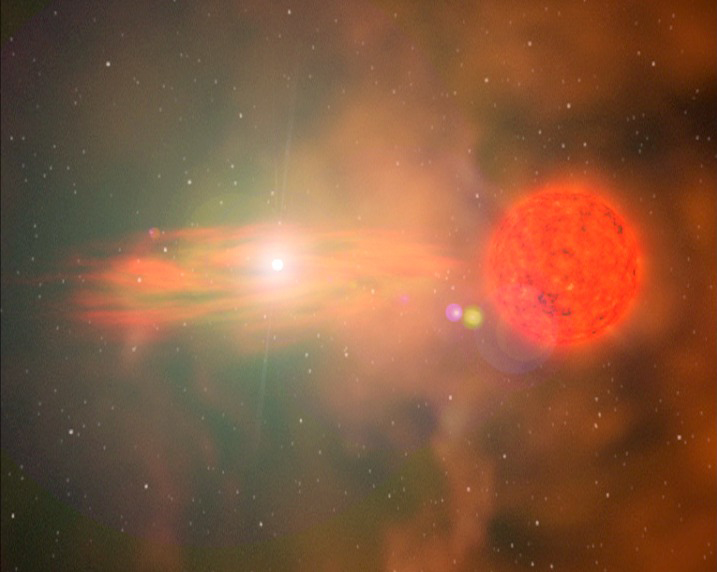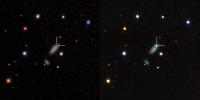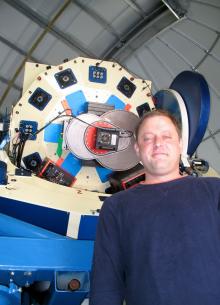


In the August 24 issue of the journal Science, astronomers show for the first time that at least some thermonuclear (Type Ia) supernovae come from a recurrent nova. The results of the study, led by Ben Dilday, a postdoctoral researcher in physics at UC Santa Barbara and at Las Cumbres Observatory Global Telescope Network (LCOGT), are surprising because previous indirect –– but strong –– evidence had pointed to the merger of two white dwarf stars as the originators of other Type Ia supernovae.
The authors conclude that there are multiple ways to make a Type Ia supernova –– a finding that could have implications for understanding the differences seen in these "standard candles," that were used to reveal the presence of dark energy.
Supernova PTF 11kx was discovered by the Palomar Transient Factory (PTF) in a galaxy 600 million light years away –– relatively nearby in astronomical terms, but like all Type Ia supernovae, much too far away to make out the details of the stars before they exploded. However, the astronomers could discern that the supernova was surrounded by shells of gas, some of it containing hydrogen that had likely been cast off in previous nova eruptions, decades before the supernova occurred. These are much more frequent weak explosions that do not destroy the star. While similar shells of material had been seen before in a handful of Type Ia supernovae, their origin was debated, and they had never before been firmly linked to novae. Some doubted that the material was even near to the supernova at all.
PTF 11kx was different. The surrounding gas was moving too slowly to be from the supernova, but too fast to be a typical stellar wind. Lars Bildsten, director of UCSB's Kavli Institute for Theoretical Physics, hypothesized that it was material shot out from a previous nova eruption, which had been slowed as it collided with the wind from the red giant star. Calculations from UCSB graduate student Kevin Moore showed this hypothesis to be plausible, and would lead to gas moving at speeds seen in the observations. Adding credence to the theory was the fact that the material moved at two different speeds –– faster-moving material interior to slower-moving material –– exactly as expected. The farthest-out material had been slowing for decades, while the interior material had less time to slow.
But if this was the case, the very fast-moving supernova ejecta should have eventually collided with the nova material. About two months after the explosion, this is exactly what happened. New observations showed that the supernova ejecta was smashing into the interior shell of material. It was impossible to doubt that this gas was near the supernova.
"This was the most exciting supernova I've ever studied," said Dilday. "For several months, almost every new observation showed something we'd never seen before."
The team was further convinced of the nova hypothesis based on its similarity to RS Ophiuchi, a recurrent nova in our own galaxy. Unlike distant supernovae, RS Oph is close enough that its properties are known: It is a compact white dwarf star (similar to what the core of the sun will become in 5 billion years) in orbit with a red giant star.
Material that is being blown off the red giant in a stellar wind is landing on the white dwarf, and, as the material builds up, it periodically explodes as a nova eruption. RS Oph has these explosions every 20 years or so, with the last occurring in 2006. But theoretical studies indicated that white dwarfs lose more mass in a nova eruption than they gain from the red giant. Since a Type Ia supernova is thought to occur when the white dwarf grows in mass until it can't grow any further, many astronomers concluded that novae could not produce Type Ia supernovae. The new study is the first observational evidence that they can.
A red giant star (foreground) loses some of its outer layers though a stellar wind, and some of it forms a disk around a companion white dwarf star.
This material falls onto the white dwarf, causing it to experience periodic nova eruptions every few decades. When the mass builds up to the near the ultimate limit a white dwarf star can take, it explodes as a Type Ia supernova, destroying the white dwarf.
Credit: Romano Corradi and the Instituto de Astrofísica de Canarias
†† Middle image: Left: Host galaxy of PTF11kx before the supernova exploded as seen from the Sloan Digital Sky Survey.
Right: the blue dot is the supernova near peak brightness as seen with LCOGT's Faulkes Telescope North.
The supernova is 600 million lightyears away in the constellation Lynx.
Credit: B.J. Fulton, LCOGT
Related Links
Las Cumbres Observatory Global Telescope Network



